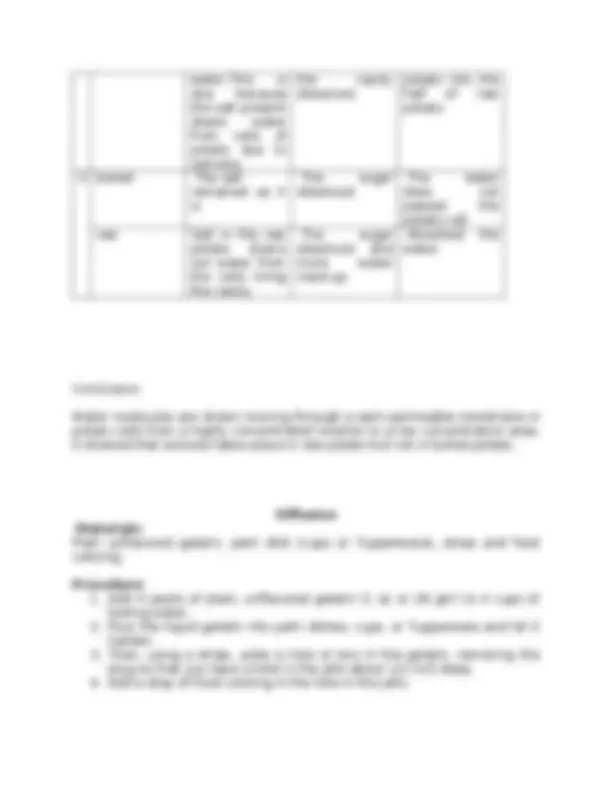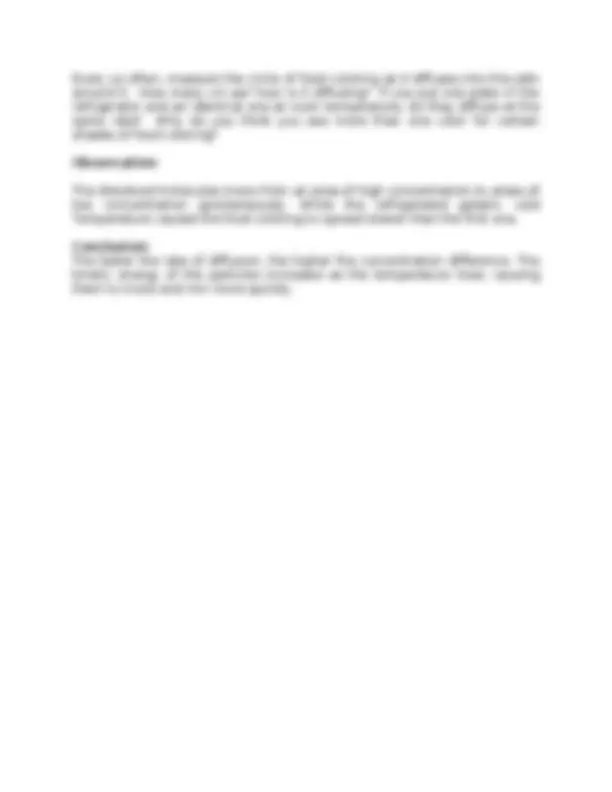




Study with the several resources on Docsity

Earn points by helping other students or get them with a premium plan


Prepare for your exams
Study with the several resources on Docsity

Earn points to download
Earn points by helping other students or get them with a premium plan
Community
Ask the community for help and clear up your study doubts
Discover the best universities in your country according to Docsity users
Free resources
Download our free guides on studying techniques, anxiety management strategies, and thesis advice from Docsity tutors
A laboratory activity focused on the concepts of diffusion and osmosis, two essential mechanisms of membrane transport in biology. Students will conduct experiments using potatoes and gelatin to observe and understand how these processes enable cells to survive by allowing the movement of materials across semipermeable membranes. The document also includes objectives, materials, procedures, and expected outcomes.
What you will learn
Typology: Exercises
1 / 4

This page cannot be seen from the preview
Don't miss anything!



Laboratory Activity 4 Diffusion and Osmosis Introduction: To stay alive, a cell must allow certain materials to enter or exit from it. This movement of materials generally proceeds along a concentration gradient. All substances that move into and out of the cell pass through a semipermeable membrane. There are two general mechanism of membrane transport: passive and active. Passive transport involves the movement of substances from a region of greater concentration to one of lesser concentration without the expenditure of cellular energy. This may be through either simple diffusion or facilitated diffusion. Active transport, on the other hand, is the movement of substances from a region of lesser concentration to a region of greater concentration – a process which requires energy. Objectives: After working on this exercise, you should be able to: a. define diffusion, osmosis, and active transport b. relate the concepts of diffusion and osmosis to the survival of living cells. OSMOSIS IN LIVING TISSUES Materials: Potatoes, water, petri-dish (plates), salt, sugar. Procedure:
Name/s: Jemina R. Acosta Date: October 20, 2021 Course/Year/Section: Bs Biology 1A Instructor: S. Pagulayan Report Sheet A. Data and Results Name of the Experiment Observation: Potato Response of tissues to substance salt sugar none 1 boiled More water in the salt cavity and salt begun to remain in cavity. Water rise up to the cavity and the sugar remain in the cavity. The potato has none cytoplasm because it was boiled and the appearance of t became brown and without water. raw Salt remain in the cavity and more water rise up in the cavity. More water rise up and a little sugar remain in the cavity and the Color of water changed The cavity became brown or gray. 2 boiled Salt in boiled potato remains same as it's cells are dead and so no osmosis takes place Water rised up and the and the sugar remained while the water slowly changed. Water does not pass from cell to cell by osmosis. raw Salt in raw potato is wet and some is dissolved in More water rised up and little by little the sugar in Water molecules move from outside the raw
Every so often, measure the circle of food coloring as it diffuses into the jello around it. How many cm per hour is it diffusing? If you put one plate in the refrigerator and an identical one at room temperature, do they diffuse at the same rate? Why do you think you see more than one color for certain shades of food coloring? Observation: The dissolved molecules move from an area of high concentration to areas of low concentration spontaneously. While the refrigerated gelatin, cold Temperature caused the food coloring to spread slower than the first one. Conclusion: The faster the rate of diffusion, the higher the concentration difference. The kinetic energy of the particles increases as the temperature rises, causing them to move and mix more quickly.